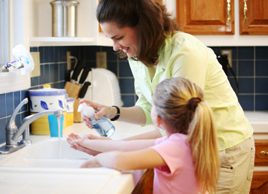10 ways to make your home healthier
Learn how to keep toxins and germs out of your home the all-natural way. These tips will help keep your home healthy and clean

Source: 1801 Home Remedies, Reader’s Digest
You’ve installed smoke detectors. Tested your air for radon and your tap water for lead. You’ve even seen to it that each bathroom has antibacterial soap and paper cups. What else can you do to protect your family against illness? Quite a lot, as it turns out’especially if you live in a tightly sealed, energy-efficient home, in which airborne toxins can quickly build up.
Use mother nature’s cleansers
No doubt you already know to open the windows and turn on a fan when using solvents, harsh cleansers and other noxious chemicals. But it’s an even better idea to replace these products whenever possible with homemade alternatives.
‘ All-purpose cleaner: Dissolve 4 tablespoons baking soda in 1 litre warm water.
‘ Drain cleaner: Pour a half-cup baking soda down the drain. Add a half-cup white vinegar. Close the drain and wait five minutes, then flush with a kettleful of boiling water.
‘ Toilet bowl cleaner: Make a paste with lemon juice and borax (available in hardware stores). Apply the paste, let set for two hours, then scrub and rinse.
‘ Oven cleaner: Sprinkle water on spills while the oven is still warm, then add salt. When the oven cools, scrape the spill away.
Get bold about mold
Many people who blame their coughing and wheezing on pet dander or pollen are actually experiencing a reaction to mold spores in their own homes. Nothing helps mold to flourish like high humidity, so do all you can to get household moisture under control. Obviously, that means keeping an eye out for roof leaks and drip-drip-dripping faucets. But you should also make sure that all space heaters, furnaces, gas logs, fireplaces, etc., are properly calibrated and well vented. In addition to producing carbon monoxide and other combustion products, these devices drench the air with water vapor.
You might want to pick up a moisture meter (hygrometer) at a hardware store. If the indoor humidity in your home regularly exceeds 50 percent, a dehumidifier should solve your problem.
Give germs the cold shoulder
No matter how carefully you clean, it’s impossible to get rid of all the germs in your home. But you can get fewer colds and other viruses simply by insisting that everyone in the household washes his/her hands before each meal and after each trip to the bathroom. Try not to touch your hands to your eyes or mouth; if germs have no way into your body, they can’t make you sick. And yes, using a disinfectant spray on doorknobs and faucets does help protect the rest of the family when one of you is under the weather.
‘ Tame your toothbrush. One place germs love to lurk is a damp toothbrush. Many viruses, including those that cause the flu, can survive for more than 24 hours on moist bristles. Solution: Alternate between three toothbrushes, so you’re using a dry toothbrush each time. If you do come down with a bad cold, replace all of them once you recover, just to be safe. Don’t like the idea of so many toothbrushes?’Use one and rinse it daily with hydrogen peroxide or mouthwash.
‘ Expunge germs from your sponge. Like toothbrushes, kitchen sponges are breeding grounds for bacteria. It’s also possible to transfer food-borne bugs, such as salmonella and campylobacter, from sponges used to wipe countertops and cutting boards to dishes and cookware. To be safe, change your sponge every week and always allow it to air-dry between uses. It’s also a good idea to disinfect your sponge with a mixture of one liter of water and two tablespoons of bleach.
Declare war on dust mites
These pesky microscopic critters feast on sloughed-off skin cells, and the droppings they leave behind can set your allergies off. How can you get rid of pests you can’t see? Once a week, vacuum rugs and upholstered furniture, and wash sheets and towels in hot water. Quilts and comforters that you don’t want to wash that frequently should be put through the dryer once a week.
If you place these items in storage at the end of each season, be sure to wash or dry-clean them first.
Get the lead out
The toxic metal isn’t found only in tap water and old paint. Although leaded gasoline has been banned for decades, topsoil in many areas remains contaminated (fallout from the exhaust of automobiles that ran on leaded gas). To be safe, always assume that soil might be contaminated. Dust regularly, and make it strict policy that everyone takes off his/her shoes before coming indoors.
Newspaper ink is another surprising source of lead contamination. Always wash your hands after handling the paper. And never use newspaper to start a fire. If you do, lead dust may be left behind in the ashes. Start your fires with kindling.
Consume less chlorine
Most tap water is chlorinated. This is a good thing, because chlorine is such an effective germ-killer. Unfortunately, chlorinated water has been linked with some pretty nasty ailments, including cancer of the bladder and rectum.
You can dechlorinate your tap water by equipping your kitchen faucet with an activated charcoal water filter. Installing a similar filter on your showerhead will minimize the amount of chlorine-containing compounds you inhale during those long, hot showers.




